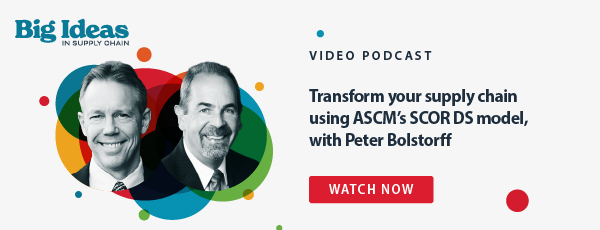The world of supply chain is constantly changing, but modern constraints, disruptions, and expectations have marked an even more fundamental shift that requires new ways of tackling current and future challenges. Disruptions to both supply and demand, along with shifts in ESG requirements are necessitating new tools and processes to reach resilience, profit, and sustainability goals.
This changing landscape is at the center of a recent Big Ideas in Supply Chain podcast conversation between Peter Bolstorff, Executive Vice President of Innovation and Business Intelligence at ASCM (Association for Supply Chain Management), and Allen Jacques, Industry Thought Leader at Kinaxis. They discuss the revamped SCOR DS (Supply Chain Operations Reference Digital Standard), a digital, open-access model providing methodology, diagnostic and benchmarking tools so organizations can make rapid improvements in supply chain processes.
Here's a brief recap of their conversation.
New tools and processes for new problems
SCOR (Supply Chain Operations Reference) is a model that’s been helping organizations evaluate their supply chain effectiveness and efficiency for more than 20 years. But modern challenges call for new tools and processes. This was really at the heart of the revamped SCOR DS, the new reference model from ASCM that has been three years in the making.
Peter explains that SCOR DS is brand new, designed to solve the problems that will need solving in 2030. Among those problems are disruptions at both the supply and demand end of the spectrum and changing ESG requirements.
To address these challenges, SCOR DS pits two infinity loops together. The first is focused on the bi-directional orchestration of supply and demand, to address the constraints and disruptions on both ends of the equation at the same time. The second is to orchestrate the synchronization of a regenerative supply chain, considering product development, material changes, and transportation. Though there are six Level-1 processes (plan, order, source, transform, fulfill, and return) sitting above them as the only Level-O process is orchestrate.
Peter notes this is a big change from how things were done in the past. “The old linear way of thinking about we do this first and this second, and this third, and this fourth was born out of technology that can only do one thing at a time.” This change really addresses the speed at which things are happening, he says. “Everything happens all at once, and so there's no longer this idea around sequential linear calculations, so that was kind of the impetus.”
One of the hot-button issues SCOR DS helps to address is resilience.
The different dimensions of resilience
Organizational resilience is top of mind for most CEOs. It is an especially relevant issue for supply chain professionals, who must manage constant disruption. For Peter, resilience has two dimensions.
He explains that operational resilience relates to being faced with disruption and needing to respond immediately. In times of disruption there is a set of processes that are followed in order to respond. He notes that many organizations prioritize this type of resilience, so they’re able to respond to disruption in real time.
This often comes at the expense of a focus on strategic resilience. This means focusing on processes and learning from current disruptions, putting those learnings into a playbook, and improving overall resilience for the organization so it can be more agile and responsive in the future.
With more severe disruptions happening more frequently, Peter suggests that it’s necessary for organizations to balance operational resilience and strategic resilience to future proof their supply chain.
Looking to the future
In supply chain, it’s necessary to always look to the future. Looking at trends, Peter highlights AI and sustainability as the clearly dominant trends this year. Specifically, how organizations can use technology like AI to become more sustainable. With some organizations greenwashing their operations and are talking the talk but not delivering, Peter suggests bringing people and technology together to help operationalize sustainability in a meaningful way.
This advancement of AI technology is creating opportunities for supply chain professionals to make a real difference. Though in some cases there will be consolidation of jobs, other roles will emerge to directly address tomorrow’s problems. And, with more sophisticated tools available, supply chain professionals will be able to make a bigger impact in a shorter amount of time.
Peter predicts that some areas like lifecycle management and substituting recyclable materials, or 3D printing – ways to make the supply chain more sustainable – will create new types of jobs for supply chain professionals. “I think the future is bright for supply chain professionals, they just need to continue to learn and adapt as we go,” Peter says.
Not only will these new capabilities allow supply chain professionals to focus on what’s important and spend more time in areas where they can add value, it also creates new opportunities for those entering the industry. Students are more excited about careers in supply chain than ever before, which makes Allen and Peter optimistic about the future.
To watch the full conversation between Peter Bolstorff and Allen Jacques, watch the full video podcast here:
Want to keep the insights flowing? Watch other recent episodes of Big Ideas in Supply Chain:






